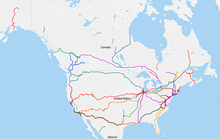Rail travel includes everything from heritage steam trains to high-speed bullet trains, from sightseeing or dinner trains to the convenience of speed as a means of modern transport.
Understand
edit- See also: Tips for rail travel

Railroads emerged in the 19th century as the first widely available means of fast land transportation, much before the rise of the automobile, and have put their mark on most countries and cities. Canada was unified only by rail until the Trans-Canada Highway was completed in 1961; in Russia, the Trans-Siberian Railway was the only coast-to-coast land transport until a Trans-Siberian Highway opened in the early 21st century.
The availability and quality of rail infrastructure varies greatly between countries. While countries such as Germany and Japan have excellent rail networks both in and between cities, passenger rail service in the United States – once a world leader in rail transport – has fallen far behind its road network, and some countries are completely devoid of rail. In the United States, Canada, Australia and New Zealand, long-distance trains are slow, infrequent, expensive and often delayed, meaning that they are primarily intended for tourists with a lot of time and money on their hand to take in the passing scenery at a leisurely pace, rather than an actual practical travel option; if you are pressed for time and/or on a budget, flying or driving yourself usually works out to be cheaper and faster. In most other developed countries, rail is the primary option for intercity (and intracity) travel where available, although buses may be cheaper. In many developing countries, trains are a relic of the colonial era and are often run-down, slow and unreliable, but are used by many locals as they cost much less than flying or buying a car.
Rail travellers might encounter timetables and information being available in local languages only, poorly translated information or hard to understand ticketing requirements.
Public transportation networks are often made up of regular trains and commuter trains, together with urban rail systems such as metro and streetcars, as well as buses.
Categories
edit
| “ | Ooh, I love trains! | ” |
—Sheldon Cooper, The Big Bang Theory | ||
- Public transportation – metro, elevated rail, light rail, streetcars etc.
- Urban rail adventures – there are interesting urban rail experiences to be had.
- Rail air alliances – while trains and planes often compete, sometimes airlines and railways cooperate.
- Sleeper trains – once the preferred way to reach many places, it is still a good way to get around in style and sometimes surprisingly cheap.
- Tourist trains
- Heritage railways
- Steam – while associated with heritage railways, there are still regular steam train services, especially in Africa and East Asia.
- High-speed rail – the most modern form of rail travel; capable of travelling at more than 250km/h without the hassle of getting to an airport and through security
- Enthusiast rail travel – some just are interested in rail transport of all forms
Africa
editAsia
editEurope
edit
- Main article: Rail travel in Europe
- European rail passes
- Rail travel in France
- Rail travel in Germany
- Rail travel in Great Britain
- Rail travel in Ireland
- Rail travel in Italy
- Rail travel in the Netherlands
- Rail travel in Russia
- Rail and bus travel in Sweden
- Rail travel in Switzerland
- Rail travel in the Czech Republic
- Rail travel in Turkey


